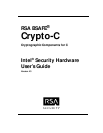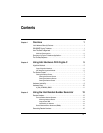
Chapter 1 Overview 3
Overview of a Crypto-C Hardware Application
Overview of a Crypto-C Hardware
Application
Creating a Crypto-C application that can use Intel’s security hardware features is
similar to creating any Crypto-C application. If you are not familiar with Crypto-C,
you may wish to consult the introductory example in Chapter 1 of the Crypto-C User’s
Guide. For an application that will use hardware, the following differences should be
noted:
Additional algorithm info types (AIs).
Crypto-C provides some AIs that are designed to
work only with hardware. These AIs extend the functionality of the Crypto-C
application when the compatible hardware is present.
Additional algorithm methods (AMs).
Recall that the AIs are merely the vessels that are
used to set up the Crypto-C programming interface. The algorithm methods (AMs) do
the actual work. In a software-only application, these methods are all part of the
Crypto-C library. For a hardware-aware application, Crypto-C makes available
additional methods that can be used to access the hardware.
Changes to the chooser structure.
The chooser specifies the algorithm methods an
application can use. In order to make your application as flexible as possible, and give
you access to hardware from multiple vendors, Crypto-C extends the chooser model
for hardware-aware applications. In this case, you create two choosers: a chooser that
contains the methods built into Crypto-C, including any Crypto-C hardware-aware
methods you need, and a second hardware chooser, that lists the methods supplied
by the manufacturer, such as Intel, of the hardware you wish to use. Then you must
call the function
B_CreateSessionChooser to combine these two choosers and actively
associate the manufacturer’s method with the generic method supplied in Crypto-C.
This created chooser can be used wherever you would have used the standard
chooser in Crypto-C.


















